
A while back I reviewed the CMA800, which was the flagship product from a brand new company called Questyle Audio Engineering. I actually screwed up and listed that review under the CMA800R heading.... I created a proper entry and migrated the original review there, and I'm now replacing this section with the proper content. Anyway, I was absolutely smitten by the CMA800's ultra-transparent presentation - it was easy to recommend for the asking price of $1,500. Since then, many others have gone down the Questyle road and arrived at similar conclusions. The Questyle name has become rather well known in a relatively short amount of time, and for good reason: their gear is excellent.
Although it was their main product, Questyle has already discontinued the CMA800. Why? To launch the CMA800R which is basically an evolution of the design, tweaked for slightly improved sound quality and increased functionality. As much as I loved the original, I think the replacement is a considerable improvement. Let's discuss why.
Actually, before we proceed, I ask that you read my original review (in its new location HERE) if you haven't already done so. That will get you up to speed on Questyle's unique Current Mode Architecture and save me from rehashing the same info all over again. Then come back here when you've finished and we can keep going.
Done? Good. Now, onto the CMA800R. The "R" model looks nearly identical to the original. At first glance you might notice one or two small differences, but generally speaking it's the same enclosure with the a very similar appearance. What's new? Let's discuss, because there's more going on than you might initially notice.
The first big one for me is the feet. It might sound petty, but I consider it worth mentioning. I gave Questyle a hard time for using pointy little "cone" feet on the CMA800 which looked great but didn't inspire confidence when stacking the amp on something. Whether it was another component (probably a DAC) or just a nice platform on your rack, dresser, or whatever you put your gear on - regardless, nobody wants to scuff up their stuff. So the pointy cones were wisely replaced by more traditional feet with soft material on bottom. Now stacking is perfectly safe, and the unit doesn't slide around so much when plugging in a headphone. Added bonus - Questyle throws in the old cone style feet as well, which can easily be installed if the user so desires. Use them if you dare.... it's nice to have options.

The next big thing is the preamp output on the rear panel. It's an RCA output, and it passes along whatever incoming signal is active at the moment. So theoretically one could use the CMA800R as a simple preamp, with two sources (one XLR, one RCA) selectable from the front panel switch. This is handy for complex systems (like mine) where you'd like to integrate several different amps all from the same DAC. Or, it could be used for driving a pair of active monitors in a desktop setup. Personally I think every amp that doesn't have a significant size or budget limitation should have this feature, and I'm pleased to see it here.
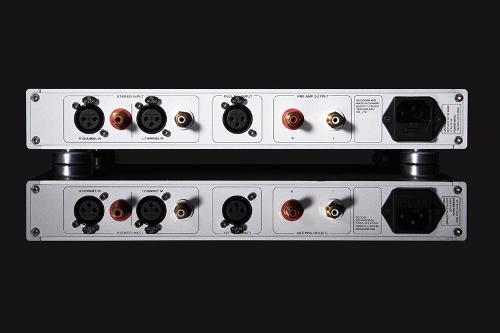
Hmmmm, what else? How about a minor change in the faceplate side "fins" for an angled look? How about a volume knob that protrudes a little more, making it easier to handle? These are welcome but really don't scream "new model name" by any means. There's got to be something more.... and there is. Questyle tweaked some internal things, nothing major, but it nets an improvement - THD is down, power is up, and the overall sound a very slightly improved. None of this is drastic by any means though. I'm talking 5% at most. It's the sort of thing where most companies would not even bother to call it "Mk2" or anything of that sort.


But wait - what's that new output jack on the front, next to the volume knob? Is that a single 3-pin XLR connection? Why on earth would you need a 3-pin connection? Balanced operation requires either a 4-pin XLR or dual 3-pin XLRs - did Questyle mess up here? And how about that lone 3-pin XLR input on the rear? What's going on here?
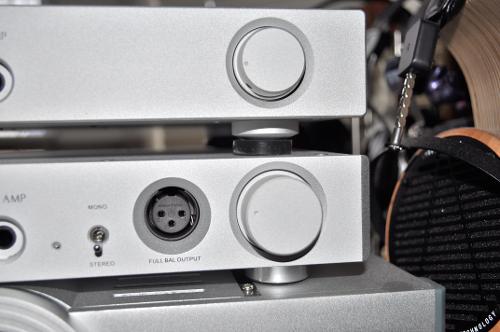
Now we're getting to the heart of this upgrade. The CMA800R is an exceptional choice when used as a traditional amp. However, it also has the capability of running with two units in a fully balanced, dual mono configuration. This brings large increases in current delivery and voltage swing (obviously) as well as completely isolating each channel which can only be a good thing. Essentially, all the benefits touted by makers of monoblock speaker amps are at play here, but this time the minimum investment starts with just one amp - add another down the road when you can afford it. Those 3-pin XLR ins and outs suddenly make more sense, don't they?
Questyle was one of the first to bring separate chassis dual mono operation to the table. Woo Audio, to my knowledge, was the first to advertise it with their ultra-expensive WA-234 ($15,900/pair) which handles both speakers and headphones - but I'm not sure we could actually buy the thing until a while later. By that time Questyle had launched their monoblocks in their home market, followed by a USA launch shortly thereafter. Both companies had claimed to be the "first" to do it, and it's close enough to where both claims seem reasonably legitimate as far as I can tell. I doubt either of them knew what the other was working on, and both actually launched (as in, I could purchase one here in the USA) within a very similar time frame. NuForce later joined the party with their affordable HA-200 ($698/pair) which doesn't really aim to compete with the others, but does have similarities to the Questyle on a conceptual level in that we get to start with just one and later add another if we want - the WA-234 only operates in dual mono.
The Questyle CMA800R sells for $1,499 meaning a pair of them clocks in just shy of $3,000. That's significantly more than the NuForce but waaaaay less than the Woo. It's also something of a "standard" price range for a top of the line headphone amp. In this field we find the Bakoon HPA-21 ($3,000), DNA Stratus ($2,700), HeadAmp GS-X mk2 ($2,800), Woo Audio WA5-LE ($2,750), a few different amps from Eddie Current, and maybe we'll top out at the Apex Teton ($5,000). There are more expensive amps out there - the previously mentioned Woo WA-234 and the Apex Pinnacle ($10,000) come to mind - but that's a rather significant jump even for someone who can afford a $3,000 or $4,000 amp.
So how does the CMA800R distinguish itself in this field? First off, I need to once again acknowledge the excellence of running a single CMA800R. At $1,500 this may very well be all the amp you need - see my review of the CMA800 and add a few percentage points of clarity. It's among the most transparent sounding amps I've ever heard, and when paired with the HD800 it may very well be the most clean, clear, resolving amp available. The price then becomes something of a bargain if that fits your sonic sensibilities.
However, when comparing a lone CMA800R to something like an AURALiC Taurus mkII, I hear the single CMA800R falling behind a little when using difficult to drive planar magnetic headphones. Specifically the HifiMAN HE-6, but also others to some extent. The Taurus has significantly more power on tap and just seems to drive all planars with authority that the Questyle can't quite match. The CMA800R still does a very respectable job - it's actually among my favorite amps for the LCD-2 and Thunderpants, and still does better than most with the HE-6. It's just that direct comparisons to the Taurus or Violectric V200 show it could benefit from increased horsepower. The dual mono setup might be just the ticket here.
Before discussing the sound in depth, I should cover the connection process. It's not complex but there's some stuff in there worth mentioning. First, you absolutely need an XLR output from your DAC or CD player. Balanced outputs are becoming more common these days so I don't really consider this an issue - even if you can't afford a higher-end DAC (like Questyle's own CAS192D for example), a number of reasonably inexpensive balanced models now exist (Yulong D200, Schiit Gungnir, and Parasound Zdac to name a few) that sound quite nice and don't break the bank.
Next, you'll need a balanced cable for your headphones. You can use a cable that terminates in dual 3-pin XLR, or you can do like I do: headphone cables terminate in 4-pin XLR, and then an adapter is used to convert that to the dual 3-pin format. I prefer the 4-pin XLR style and I see it slowly becoming the standard.... but obviously Questyle needed separate jacks for each amp, so the dual 3-pin jacks make total sense here. I use a really nice adapter from the CablePro Freedom series, and I'm very pleased with it. Any reasonable cable firm should be able to make one of these for you without charging an arm and a leg.

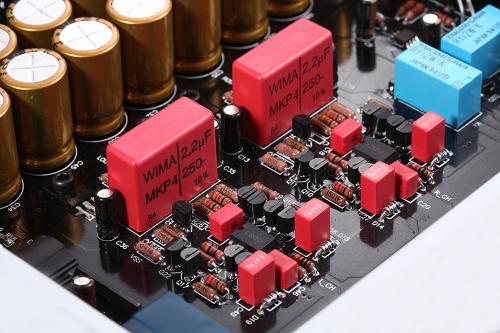

Lastly, and this is sort of optional: you might want to have volume control on your DAC. The CMA800R has the same high gain as the original CMA800, which means it gets rather loud, rather quickly. There's not a whole lot of travel on the volume knob to dial it in just so. Using the dual mono setup, each channel needs to be matched by hand - so you can see how the somewhat touchy controls would be a little inconvenient. Amps with independent controls for each channel are not common but there have been a few out there over the years - specifically the DarkVoice 337, La Figaro 339, HeadRoom Blockhead, as well as the HeadAmp KGSS electrostatic amp. Anyone who has used one of these knows it's a situation easily lived with, yet also sort of annoying at times. If you tend to switch headphones often, or listen to a contrast of music (ie a quiet jazz album followed by a modern pop album back to back), matching the channels each time can become tedious. Doubly so when gain is on the high side as it is here. If you stick with the same headphone and listen to similar music most of the time then you can set them up once and leave them alone for the most part. But that won't work for me. My solution is to set them at a fairly high level, then ease back the volume from my source. My Resonessence Labs Invicta Mirus can attenuate up to 35dB on 16-bit material with no loss of resolution (mathematically or subjectively). Plenty of other DACs do a good or even great job of this as well so I see no problem using it. Questyle's own CAS192D doesn't have variable output so in that case I just make do with the separate volume knobs, though I suppose I could use a preamp in the chain if I really felt the need. The SPL Volume2 seems to fit the bill and at $449 it isn't obscenely priced - that's probably the direction I'd go if I wanted the full Questyle stack but didn't like individual volume knobs. Either that or wait for Questyle to finish their preamp - it's currently in the works but I don't know the release date. It will most certainly cost more than the SPL but will be a more upscale design and will have the same form factor as the CMA800R.
Equipment
I've been using the CMA800R for a while now, so I'm very familiar with it. When the second CMA800R arrived I threw it right into my reference system - Aurender X100L music server feeding an Audiophilleo 1 with the PurePower battery option, out to the Resonessence Labs Invicta Mirus DAC, then the dual CMA800R monoblocks driving a variety of headphones. Power conditioning done by an APC S15, all cables were Cabledyne Reference Silver except for the CablePro XLR adapter and the various headphone cables from Toxic Cables, Charleston Cable Company, and Effect Audio depending on the headphone. I later tried a variety of other DACs including the Questyle CAS192D, the B.M.C. PureDAC, the Esoteric D-07x, and the Calyx Femto, just to see how the amps responded to different sources. I'll discuss that later.
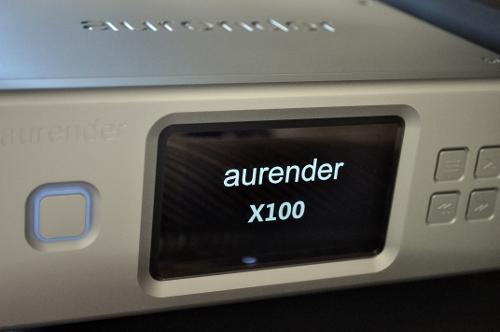

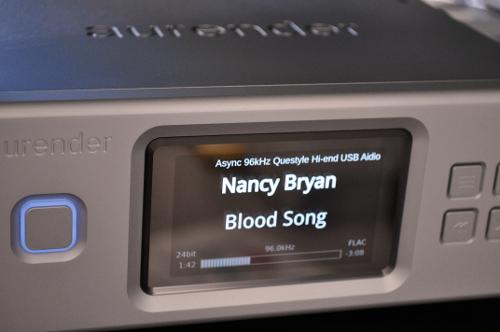



Listening
The first headphone up was the Sennheiser HD800, which is where the "800" in CMA800R comes from. This is the headphone Questyle used as the main reference when designing this amp and it really shows. A single CMA800R is already my favorite amp for this particular headphone. How would two amps improve that situation? My first impression was..... slight disappointment. I wasn't hearing any drastic changes - no veil lifted, no clouds parting, no added details in my favorite songs that I never knew existed. Then again, it was already on such a high level with one amp that it would probably be unrealistic to expect a major change. So I settled in and tried a wide variety of excellent recordings until I got more of a handle on the differences.
What I eventually determined was that the dual mono, fully balanced setup was primarily more expansive, as well as more accurate in terms of imaging. This was already a very spacious and precise system but the monoblock configuration made it that much more believable. Frankly, I'm not sure I've heard a headphone system with such a well developed sense of space. Granted, the $5,000 Invicta Mirus surely has a large part to play here, as does the Audiophilleo, and the Aurender, and every other little detail in the system. But I later noticed an improvement in this area no matter what DAC I was using (assuming it was of reasonably high caliber) - going from a single amp to dual always resulted in a more lifelike spacial presentation. As much as I adore my electrostatic rig - using a supercharged KGSShv amp to drive the Stax SR-007 - the dual mono CMA800R plus HD800 has it beat hands down in this particular area.
Obviously this isn't going to matter when you play your favorite Beastie Boys album... you'll need to use material that contains this information in the first place, in order to hear this improvement in spacial detail retrieval. I had great results from many of the currently "popular" audiophile labels such as Reference Recordings, Mapleshade, Blue Coast, MA Recordings, and 2L. Also lesser known (at least that's my perception) but no less excellent, Opus 3 and Proprius have some really enjoyable stuff in their respective catalogs... though I'm pretty much done listening to Jazz at the Pawnshop for the millionth time. With material from these excellent labels, I was able to hear deep into the mix, discerning the characteristics of the room and where each performer was located within the boundaries of that space. Pretty amazing stuff. I also had fun with the classics like Mercury, RCA, and Blue Note, and although these were not as well carved out, they still contained a good sense of order within the recording space. And I was occasionally surprised to hear information buried in a JVC XRCD that I haven't played in a while. Redbook CD? Yeah, absolutely still viable as a format when done right.
This continued from other well known labels such as Chesky and MFSL to more obscure ones like Audiofon. Using the Aurender X100L server made it simple to browse through my multiple terabyte library to find all this stuff. The general rule of thumb was this: dual mono mode sounded discernibly superior with any recordings that had suitably high aspirations. The best of the best, for the most part, were more clearly fleshed out on the dual mono stack. Good but not quite great recordings, without the inherent ultra-realistic sense of space, still showed some improved clarity and dynamic gusto - not a massive change, but enough to appreciate. In the end I'd say the HD800 was most certainly improved in this configuration, but it also placed requirements on the listening material which may not mesh with some users. If you're not interested in exploring new labels and possibly music that you wouldn't ordinarily try, it may not be worth the expense. Again, this is not really a shortcoming of the dual mono setup, but rather due to the extraordinary sound a single amp already achieves with the HD800.
Next I tried the most difficult headphones I own, the HiFiMAN HE-6. The single CMA800R did a respectable job with these but still fell short of the "magic" I know them to be capable of when used with a more powerful amp. Running monoblock mode obviously increases the current and voltage delivery, so I was curious to hear how it would play out. I was not disappointed. With several full Watts on tap and voltage swing through the roof, this was a potent combo indeed. I got a sense of control and grip that was a lot less prominent with the single amp, helping the HE-6 avoid that upper midrange sharpness it can sometimes display. Bass impact was significantly improved too - I could now do justice to all my favorite Maggotron tracks, though as usual the "bass music" gimmick wears off after about 10 minutes. The improvement on the HE-6 was less subtle than it was on the mighty Sennheisers - I think most people would be able to appreciate it right away, even when playing something as pedestrian as Jimmy Eat World or Swedish House Mafia. There's a significant increase in layering, but the main thing is a more well-rounded, organic tone. On a single amp there's a definitely focus on quickness and leading edges, which are top notch thanks to the current mode architecture producing vanishingly low distortion measurements. Adding another amp rounds out the decay, making for improved transients and more realistic timbre. Despite HiFiMAN moving on to their new i-series, the HE-6 remains a top performer when paired with good enough amplification, and the dual CMA800R is up there with the best I've heard for these headphones.

After the huge improvement of the HiFiMAN flagship, I figured it was time to try the Audeze LCD-3. The big Audeze, being more sensitive than the HE-6, doesn't really need bulldozer levels of torque to drive it properly. But it isn't afraid to show any weakness in the chain either. The single CMA800R already does a good job here. Perhaps not on the same level as it does with HD800, but still competitive with other amps I have in the four-figure price range. So I didn't have massive expectations.... I figured it would be more like the HD800 than the HE-6. I was way wrong.
The LCD-3, for the first time in my experience, sounded like it was actually worth the price increase over the LCD-2. I've always said that I enjoyed the 3 and appreciate the accomplishment Audeze has made, but wouldn't recommend shelling out double to get the relatively modest improvement it brings compared to the 2. With the fully balanced dual mono Questyle system in play, I started to eat my words. The sound was simply more "alive" for lack of a better term. All the usual cliches about vocalists being in the room with me, or hearing subtle harmonies I hadn't noticed prior? Sure, those work, but they don't really get to the heart of what I'm trying to express. A good example comes from the old Sheffield Lab drum test disc, of all things. The CMA800R sounded great by itself - dynamic, expressive, full bodied - pretty much as good as I'd like it to sound. Or so I thought. Switching to dual mono, I got an immediate and obvious increase in snare drum "snap". Cymbals had more convincing decay. Bass drum thumps were not only more impactful but also had superior texture. In short, everything just sounded more like a real drum set, which is probably something only a drummer would understand. Or at least someone who listens to a lot a live drum performances. Same deal with piano - I don't really play but a family member does, and as such I'm accustomed to hearing it from the other room on a regular basis. I don't care how amazing my 2-channel rig might be at any given moment, I've never had a setup that would trick me into thinking it was the real piano instead of a recording, when heard from down the hallway. The analogy falls apart when we talk about a headphone system, but still - playing Hiromi's Haze off her album Voice (I used an SACD rip from the rare Japanese release, but a standard CD version is also excellent), the dual mono setup comes significantly closer to fooling my brain, where the single amp "merely" sounds like an excellent reproduction, nothing more. Not that anyone in my house ever plays piano like that, but you get the idea.
Is it the extra voltage swing? The higher current delivery? The improved crosstalk due to physical separation? The beefier power supply by virtue of doubling the regulation and capacitor reserves? Don't know, don't really care. All I can say is - this combo rocks. I tried it with the LCD-XC, Alpha Dogs, HD650, and a Grado PS-500, with each one showing various levels of improvement. The planar magnetic models seem to love soaking up the extra juice, while the dynamic designs seem more concerned with the improved separation and transient response. It did make me wish every headphone came standard with balanced termination or at least removable cables - I had a Fostex TH900, beyerdynamic T1, and Thunderpants which were all hardwired as 1/4" termination, meaning I wasn't able to give them a spin. I imagine I would have heard improvements there too but I could be wrong.
Let's recap for a minute - difficult to drive headphones show the biggest improvement here, with LCD-3 and HE-6 each getting a significant boost. The HD800, already a champ with a single amplifier, gets a more subtle upgrade - which may or may not be worth the trouble depending on your listening preferences. It really comes down to system matching and what you hope to achieve from adding another CMA800R to the mix.
Speaking of system matching.... let's talk DACs for a second. As I said, the best results I got was from my Resonessence Labs Invicta Mirus. The dual mono CMA800R setup is extremely resolving and really lets the Invicta Mirus soar to incredible heights. Unfortunately not every source is as capable. With the amps being brutally revealing of every flaw, I really needed the right DAC for the job. On the plus side, the right DAC was not always the most expensive.
I actually didn't really care for the $7,000 Calyx Femto in this system. It reminded me a lot of the Esoteric D-07x which I also struggle to love. They both have plenty of zip and zing, but not enough "meat" to the presentation. Everything is so fast and lean and in your face - "look at me I'm a detail!!!!!" It's great for a demo but for long term? Music doesn't really sound like that in my experience. I prefer a more natural and organic presentation, though not rolled off or dark either. Thus, I did far better with the less expensive B.M.C. PureDAC which has a wonderfully rich, full bodied tone, while remaining incredibly accurate. Questyle's CAS192D was also excellent (as you'd expect for matching components) with a neutral but definitely not boring presentation that ticked most of the boxes (the exception being lack of volume control). I also had great results with the Yulong DA8 and even the inexpensive Yulong D200 which goes for well under a grand. All in all I'd say there's plenty of choice for driving the dual mono setup, but you gotta stay away from anything too lit up (unless that's your preference, then by all means go for it).
CONCLUSION
Is the dual mono CMA800R setup worth it? That's a question I get rather often. I can't really say definitively that it will be worth it for everyone, but for me it seems like a no brainer if the budget allows. I won't promise night and day improvements across the board and in some cases (especially HD800) the improvement is conditional - only certain types of listeners will reap the benefits. In other cases it's more drastic and fairly obvious to my ears, taking the solid performance of a single amp and lifting it up to world class. DAC matching takes a little care but isn't terribly difficult so there really isn't an excuse not to go for it.
Overall I'd say Questyle has done it again. When I reviewed the original CMA800, I mentioned how a few other brands use some variation of current-mode operation, but Questyle has their own unique interpretation which sets them apart. Likewise, a few other brands have separate, dual mono, fully balanced headphone amps on the market, but none do it the same way as Questyle - the Woo uses tubes and has a price tag in the stratosphere, while the solid state NuForce is a relatively affordable solution not meant to compete in the big leagues.
The Questyle CMA800R, while not cheap, is already an excellent amp when used alone. Adding another turns it into a world class powerhouse that can challenge most anything on the market. The fact that we get to incrementally upgrade rather than buying all at once makes it that much sweeter. I heartily recommend it assuming you have the proper source and headphones to take full advantage.
Company Info
North America:
Questyle Audio North America.
Attn: Mr. Bruce Ball
Add: 8825 Urbana Ave. Arleta, California, 91331 USA
Tel: 323-834-9678
Email: bruce.ball@questyleaudio.com
Everywhere else:
Questyle Audio Technology Co.Ltd. Attn: Alden Zhao
Add: Room 801, Block B Jialin Highrise, Shennan Road 2001, Futian District, Shenzhen, China
Tel: +86-755-82835670
Email: alden.zhao@questyleaudio.com

